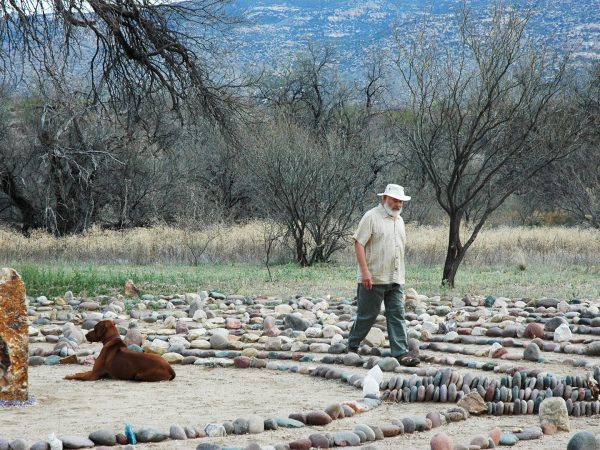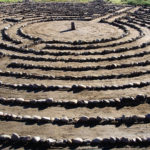Loving The Labyrinth

The last few years have been filled with many difficult challenges. All life is a journey, and the path is seldom straight. We can bemoan the twists and turns involved in getting from A to B this year especially (or, to extend the metaphor, from A to Z over a lifetime), but why not celebrate them? Do not forget to take a moment and remember to focus not only on the challenges, but on all the myriad reasons for being grateful.
That is one of many lessons taught by an age-old tool, like this one on Dr. Weil’s former southeastern Arizona homestead. It is a labyrinth, a modern reconstruction of an ancient form that has fascinated people for millennia.
“They are found all over the world,” says Dr. Weil, waving a hand at the 12 concentric circles of stones. “A labyrinth isn’t a maze. A maze is designed to confuse you. A labyrinth has one way in, one way out, and lets you see where you are at all times. It’s really a meditation device.”
The idea of building this one came from a close friend and master gardener. Dr. Weil and many friends decided to copy the pattern of the famed labyrinth laid into the floor of Chartres Cathedral near Paris, France, which was built sometime around the year 1200. Using techniques (see http://www.labyrinth-enterprises.com/tapec1.html) honed by Labyrinth Enterprises, a company that has built these unique structures all over the world, he used a center stake and string to mark the 11 concentric paths and the central chamber, making a pattern 80 feet across, roughly the same size as the one at Chartres. We began placing stones on the circles drawn with the string and a stick in the hard desert earth.
A couple of dozen people worked on it piece by piece, including Andy and his friends on the weekends, but most of the work was done by Dr. Weil, close friend Tamarack Little and some ranch hands. They started by placing river rocks that they collected from the nearby wash, but once that became “a little too arduous” says Dr. Weil, “we trucked in enough rock to finish it.”
One of the final acts of construction required the group to determine the precise position of the sun on the spring equinox. Dr. Weil recalls “standing in the cold morning air, waiting for the sun to rise, and using three sticks to line up the entrance…so the sun’s energy pours into the heart of the labyrinth.” The final rocks were laid, including “lunations,” little spikes around the perimeter that “are supposed to collect and focus energy,” says Dr. Weil.
Even before it was finished, Dr. Weil and others noticed an “odd acoustic pattern” near the center – speaking or clapping hands yields a sort of head-in-a-bucket echo. Probably caused by the focusing effect of sound bouncing off the rock circles, it is nonetheless, “pretty weird,” Dr. Weil says.
Once it was done, they all came away convinced that anyone can make a stone labyrinth, or just tape one off in their school gymnasium. They can be any size; I built one that’s eight feet across in my backyard.
As to “doing” the labyrinth, the task is simplicity itself. “You just follow the path,” says Dr. Weil. “It takes about 20 minutes.” He says there is no particular mindset one must bring to the experience, but he notes with a smile that “grimly determined to finish it as quickly as possible,” probably isn’t the best way to go. One of Dr. Weil’s favorite activities is watching groups walk the path. “It’s interesting, because they look like planets, with some of them going retrograde,” he says.
But many people walk it alone. Nancy Olmstead, Dr. Weil’s executive assistant, has done so more than 20 times. “When you are done walking, you experience two things that would seem to be contradictory: you feel really relaxed, and really energized,” she says. “There are not too many things in the world that make you feel that way.”
Dr. Weil likes this metaphor: One path. One entrance. One exit. We all walk it, “I would say that it is at least relaxing. It’s a nice walk. It is centering.”
There are actually two adventures here. The first is a heart-in-mouth climb up a steel ladder attached to a swaying eucalyptus tree, which leads to a viewing platform that’s a good 40 feet above the ground. Being up there gives you another perspective on the labyrinth, on the order and geometry of the thing. As the eucalyptus creaks in the wind, it also gives you some perspective on how many decades it has been since you climbed a tree that high.
The time had come to walk the labyrinth itself. We did so alone on a sunny, cool, early spring afternoon. The first thing we noticed is that what looks like a simple path is, in fact, surprisingly complex. The Chartres design cleverly takes the walker quickly to the edge of the inner circle – which, to the modern mind is clearly “the goal” – and then just as quickly takes him or her back to the outer edge. Close, far, middle distance, far, close, far; then suddenly, the center!
There was a lesson here, but it did not become clear until the winding trip back out. The way in had been surprisingly frustrating, but somewhere during the trip out, our attitudes changed. Because we knew that simply following the path would take us to the exit, we realized we were free to focus on the walk itself. Amazing to find a strange, beautiful collection of objects lodged between and atop the rocks: a tiny stone Buddha, several glass beads, a quartz crystal. We had missed most of them on the way in; but marveled at all of them on the way out.
“I never quite know how they get there,” says Dr. Weil of the artifacts. “People just leave little gifts.” Gifts indeed. The lesson was clear: Focus on the journey. The destination will take care of itself.
Note: On a stormy summer day in the southern Sonoran desert, the labyrinth was destroyed by a flash flood caused by heavy monsoon rains, but was rebuilt the following February. For those who wish to build their own or learn more, Dr. Weil personally recommends the books, “Walking a Sacred Path: Rediscovering the Labyrinth as a Spiritual Tool,” by Dr. Lauren Artress, and “Labyrinths and Mazes” by Jurgen Hohmuth.












